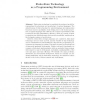Free Online Productivity Tools
i2Speak
i2Symbol
i2OCR
iTex2Img
iWeb2Print
iWeb2Shot
i2Type
iPdf2Split
iPdf2Merge
i2Bopomofo
i2Arabic
i2Style
i2Image
i2PDF
iLatex2Rtf
Sci2ools
108
Voted
CICLING
2007
Springer
2007
Springer
Finite-State Technology as a Programming Environment
Finite-state technology is considered the preferred model for representing the phonology and morphology of natural languages. The attractiveness of this technology for natural language processing stems from four sources: modularity of the design, due to the closure properties of regular languages and relations; the compact representation that is achieved through minimization; efficiency, which is a result of linear recognition time with finite-state devices; and reversibility, resulting from the declarative nature of such devices. However, when wide-coverage grammars are considered, finite-state technology does not scale up well, and the benefits of this technology can be overshadowed by the limitations it imposes as a programming environment for language processing. This paper focuses on several aspects of large-scale grammar development. Using a real-world benchmark, we compare a finite-state implementation with an equivalent Java program with respect to ease of development, modu...
CICLING 2007 | Language Processing | Natural Language | Natural Language Processing | finite-state Technology |
Related Content
| Added | 07 Jun 2010 |
| Updated | 07 Jun 2010 |
| Type | Conference |
| Year | 2007 |
| Where | CICLING |
| Authors | Shuly Wintner |
Comments (0)

